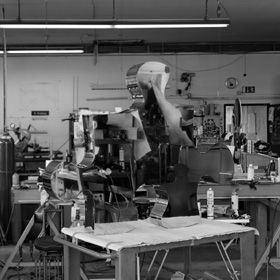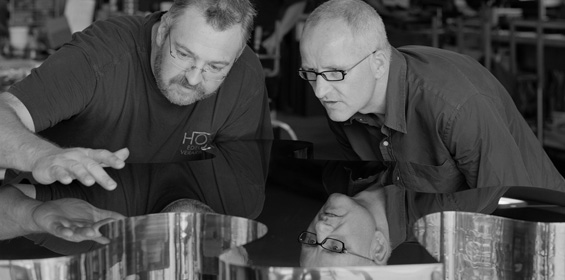As lasting as stone and as light as a bird
The imaginary time journeys of Georg-Friedrich Wolf’s steel sculptures
“My sculptures narrate the history of humanity, the history of technology, and the attempt to control the forces of nature; they are about swords and ploughshares. The entire polarity of our existence is the polarity inherent to steel.” (Georg-Friedrich Wolf)
In contrast to bronze, iron and steel are not traditional materials of the art world, where they became established in the 1960s only. Steel, however, is one of the oldest engineering materials. Its main component is iron and it can be forged, bent, rolled, and drawn, either cold or at high temperatures. Steel is very strong, but due to its ductility it is actually “softer” than the related very hard and brittle wrought-iron, which is well suited for use in mechanical engineering and structural elements, but cannot be forged. Georg-Friedrich Wolf values steel for its robustness and high durability together with its flexibility to take on a wide variety of shapes in virtually unlimited dimensions.
The history of steel goes back to the epoch described as the Iron Age. In the Near East, as early as the second millennium BC, the Hittites documented the smelting of iron ore along with the production of steel that could be forged and hardened.
At that time already, the forged nail was crucial, which explains its presence as a central motif in Wolf’s work. Nails hold anything together that requires an essential structural connection. No bridge, no ship, no edifice would ever have been built without a nail. In this sense, the nail is the signet of human technical and constructive proficiency and is a symbolic link between the prehistoric Iron Age and the start of the age of heavy industry in the 18th century – shaped by coal and steel.
That age, in turn, is principally associated with blast furnaces, stamping and rolling mills. Adolph von Menzel’s oil painting, “The Iron Rolling Mill” (1872–1875, Alte Nationalgalerie Berlin), epitomises art-history’s perhaps most famous tribute to this technology. “Modern Cyclops“, the work’s second title, set in brackets, is also evocative of antiquity.
Steelmaking has forged political alliances that still subsist today. The European Coal and Steel Community, for example, founded in 1952, has facilitated the uniform control of coal and steel production throughout a range of countries. The organisation thus became the nucleus of the European Union, where a standardised regulatory framework on the use of artificial intelligence is currently on the table.
Georg-Friedrich Wolf’s steel sculptures build an imaginary bridge across the industrial revolution back to the Iron Age; at the same time, they cast a glance both into our digital present and into the future. In art history, the works share the comparatively short tradition of iron and steel sculpture that only began when the heyday of heavy industry characterised by steel processing was already practically over. In the 1960s, American Minimal Art, which deliberately worked with industrial materials and serial structures, confronted Donald Judd’s polished stainless-steel cubes with Carl André’s partly oxidised steel floor plates. The aesthetic appeal of rough steel surfaces strongly emphasised in Wolf’s work has been particularly highlighted by two artists: on the one side, Richard Serra with his monumental works in straight or curved steel; on the other, Eduardo Chillida, who comes from the Basque Country, with sculptures that oscillate between abstraction and figuration, geometry and organic forms. The latter are frequently installed in outdoor spaces to mark major public or corporate buildings. Despite the large size of Chillida’s works and the weight of the material, they often convey an impression of almost floating lightness, an aspect that is likewise found in Wolf’s work. As the Mexican Nobel Prize winner Octavio Paz wrote, some of Chillida’s sculptures appear to be “like a bird, like a sign of space.”
Wolf, too, works with the emblematic effect of his sculptures’ silhouettes: despite their monumentality, they stand out from a wall or against the airy expanse of the sky in an almost graphic quality. The artist links this feature to his process of creation: “I move my tools intuitively, without having to think and yet with great precision, like a graphic artist who lets his pencil fly over the paper.”
Hence, steel can be used for imaginary drawings in the air, which is particularly perceptable when looking at the sculptures from a long distance away. But there are other nuanced effects that become all the more apparent the closer you get to the work. Finally, to put it in Wolf’s words, the eye meets a “scaled and scarified surface, often resembling leather, as if the glowing embers of the forge had been stored within it”. This is reminiscent of the cracked and burnt-looking crusts of colour observed since the 1950s in the works of Art Informel artists such as Antoni Tàpies or Emil Schumacher, and later with Anselm Kiefer.
Here, the vast devastation of the Second World War had been a factual experience. Some of Wolf’s works likewise remind us of the ruins and relics of war but the association with fragments and parts that could have been unearthed during an archaeological excavation is more powerful.
Many of Wolf’s titles refer to Greco-Roman Antiquity, as is the case with the fire-bringing Prometheus to whom the artist dedicates a full cycle of sculptures. On the one hand, the artist creates an imaginary link between the Iron Age and the industrial revolution until the present day, while on the other, he conceives an associative space in terms of contents, reaching from ancient mythology through to our digital age. Future generations will possibly look back on these works the same way archaeologists explore the past today. Ultimately, Wolf’s sculptural oeuvre addresses a spread of time which far exceeds his own lifespan and that of present-day
viewers.
This form of projection into prehistoric and future times repeatedly occurs in contemporary art, but has – to my knowledge – not yet been analysed as the coherent trend in which Georg-Friedrich Wolf could be inscribed.
Around 1970, the land art artist Robert Smithson explored the relics of the declining heavy industry in Passaic, his home town in New Jersey, as if they were vestiges from archaic times: “Since it was Saturday, many machines were not working, and this caused them to resemble prehistoric creatures trapped in the mud, or, better, extinct machines – mechanical dinosaurs stripped of their skin.” 1
Bogomir Ecker’s “Stalactite Machine” has been on display at the Hamburger Kunsthalle since 1996. It is conceived as a work that will last for 500 years; come the year 2496, it is expected to have produced a stalagmite of an approximate height of five centimetres. Adriane Wachholz’ “Our Elements” (2016–) is designed for an even more distant time, in which our contemporary world will appear as faraway prehistory: the German artist has enclosed 16 of her drawings based on icons of art history, from Leonardo’s swirling water to Hokusai’s great wave, and works by contemporary artists, in individual glass receptacles made for anatomical preparation and accordingly filled with a mineral liquid. Over thousands of years, the paper will slowly fossilise, or more precisely silicify, while the graphite drawing will remain intact.2
This piece involves the idea of a time capsule containing information on our era and civilisation and addressing later earthlings or potential beings from other planets. This same idea is at the base of the exhibition “hundert objekte zeigen die welt”, staged by film director Peter Greenaway at the Hofburg in Vienna in 1992.
Georg-Friedrich Wolf similarly dispatches imaginary time capsules. Many of the works in his cycle “The Poetry of Data” bear encoded information forged in steel, which is likely to be preserved thoughout the coming millennia. But will our descendants be able to read and understand the data? They will face the same problems as today’s researchers, who have great difficulty in deciphering the inscriptions on ancient stelae or obelisks and sometimes still fail. Nevertheless, owing to the durability of the carrier material, the messages have been safegarded either in their entirety or at least in fragments, even if the deciphering code is missing.
Georg-Friedrich Wolf asserts that “the obelisk is the memory stick of antiquity”. He thus builds another bridge, built as if for his return from the distant future and reaching out from the present time to the equidistant past. The message is conveyed by a material that is as lasting and rugged as stone – with which we usually associate former geological periods – and can yet appear to be as light as a bird flying away
1 Robert Smithson, The Monuments of Passaic, Artforum Vol. 6, No. 4, December 1967 (https://holtsmithsonfoundation.org)
2 Cf: Ludwig Seyfarth, Projected Time, In: Adriane Wachholz, OUR ELEMENTS, catalogue edition 2019.


